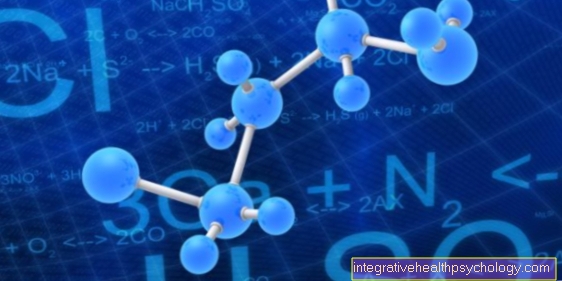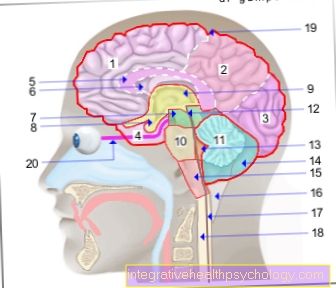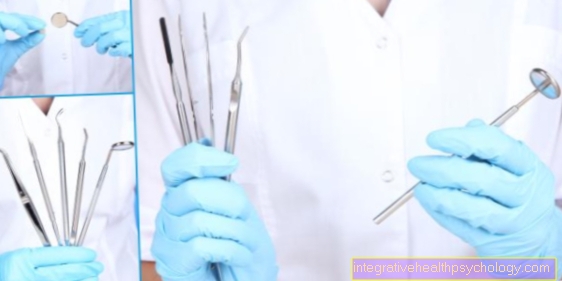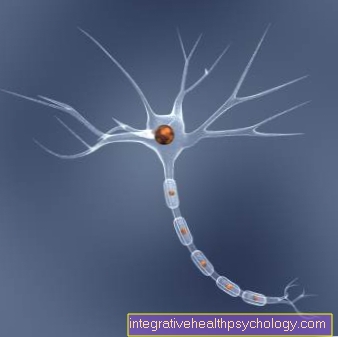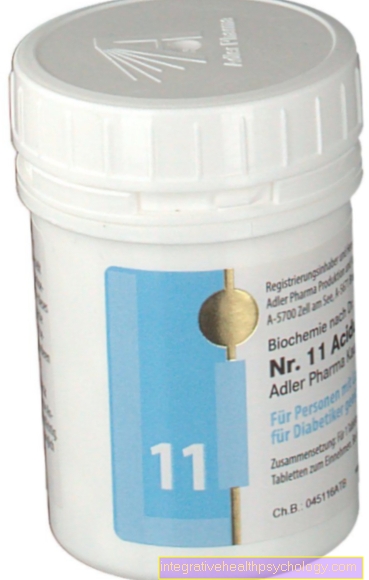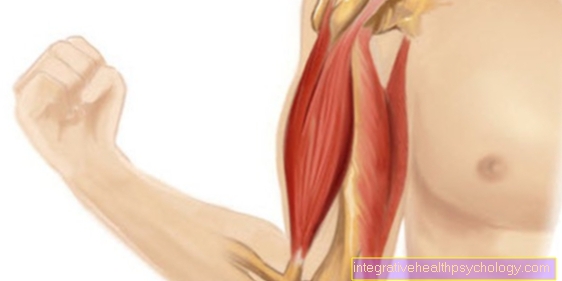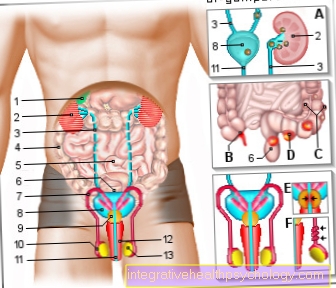Cushing's Syndrome
Synonyms in a broader sense
- Hypercortisolism
- Cushing's disease
- endocrine and exocrine Cushing's syndrome
English: Cushing’s syndrome
definition
In Cushing's syndrome (Cushing's disease) there is too much cortisol in the body. Cortisol is a hormone that is produced by the body itself, but is also used as a drug, e.g. To suppress inflammatory reactions.
Overactivity of the pituitary gland (Pituitary gland) due to a tumor or a tumor of the adrenal gland, the body's own increased production and release of cortisol can occur.
Cushing's syndrome is an example of a condition associated with overactive adrenal glands. The overactive adrenal glands have serious consequences for the body. Find out more about this topic at: What are the consequences of an overactive adrenal gland?

Regulatory processes in the body
Cortisol is normally produced in the body in response to the signal from ACTH and released into the bloodstream.
At the beginning of the hormone chain is the CRH, which is formed in the hypothalamus, a specific region of the brain. The CRH (Corticotropin Releasing Hormone or Corticoliberin) stimulates the pituitary gland to release ACTH into the blood. ACTH (adrenocorticotropic hormone) is a hormone that is produced by the pituitary gland and also released into the bloodstream. This stimulating hormone reaches the adrenal gland via the bloodstream and promotes its activity. The adrenal activity ultimately creates cortisol.
If more cortisol is now formed in the body and is in the blood, the formation and release of CRH and ACTH decreases. The cortisol thus has an inhibiting influence on the formation of these two hormones. This mechanism is called negative feedback and since cortisol acts on two hormones, this particular mechanism is called double negative feedback.
Cushing's syndrome due to cortisone
Cushing's syndrome is caused by excessive amounts of cortisone in the body. Cortisone is a very important hormone produced in the human body. It controls various signaling pathways in the body that are particularly important in times of stress or hunger and usually lead to an increase in blood sugar levels. Therefore, cortisone is also used as a drug for various chronic diseases.
However, too large an amount of cortisone has side effects such as fat redistribution, osteoporosis or the development of blood sugar disorders. If these symptoms occur together, they are grouped under the Cushing syndrome.
The increased cortisone can result either from excessive drug intake or from overproduction by the body itself. The pituitary gland, part of the brain, and the adrenal cortex are particularly involved in the production of cortisone. If one of these organs sends signals that are too strong to produce cortisone, the amount in the blood increases and Cushing's syndrome occurs. Most often this is due to a benign tumor disease of these organs.
Forms of Cushing's Syndrome
Too much cortisol in the body can be caused in two ways:
On the one hand, the cortisol in the body is increased when it is administered externally as a drug for therapeutic purposes, such as e.g. may be necessary in the case of a chronic inflammatory reaction (for example in rheumatic diseases). This form of the disease is also known as exogenous Cushing's syndrome.
On the other hand, it is possible that the body produces too much cortisol itself and releases it into the bloodstream, as is the case with endogenous Cushing's syndrome. In this form of disease there are different subgroups that differ in where the overproduction of the hormone takes place. If an adrenal tumor is responsible for the formation of too much cortisol, it is called adrenal Cushing's syndrome.
When the pituitary gland releases too much ACTH, the adrenal gland makes too much cortisol; this dysregulation of hormone production is known as Cushing's disease.
Usually there is a small, hormone-forming tumor in the pituitary gland, which is responsible for the excessive ACTH formation.
ACTH can also be produced by tumors that are outside the pituitary gland such as a lung tumor. In these cases one speaks of an ectopic formation of ACTH. Ectopic means that the ACTH is not formed in the place where it would be formed in the body under normal conditions.
The various forms of Cushing's syndrome and their subgroups are clearly shown again in the following table:
- Exogenous Cushing's Syndrome due to drugs
- Endogenous Cushing's Syndrome (Cushing's Disease)
a. adrenal Cushing's syndrome
b. central Cushing's syndrome, also called Cushing's disease
c. ectopic ACTH production
Find out all about the topic here: Cushing's disease.
What is the Cushing Threshold?
Cushing's syndrome describes a group of symptoms that result from excessive cortisone levels in the blood. The symptoms are, for example, the development of diabetes mellitus, or a full moon face, trunk obesity, stretch marks on the abdomen or osteoporosis. The most common reason for the occurrence of Cushing's syndrome is the excessive intake of drugs such as cortisone or similar substances, which all belong to the group of so-called glucocorticoids.
Hence, there is the Cushing Threshold with these drugs. It indicates the maximum daily dose that can be taken of the corresponding drug. If this dose, i.e. the Cushing threshold, is exceeded, the level of cortion in the blood rises and the risk of developing Cushing's syndrome increases.
The Cushing threshold when taking cortisone is around 30mg per day in adults. Artificially manufactured glucocorticoids that work in the same way as cortisone are for example prednisolone or dexamethasone.
When taking prednisolone, the Cushing threshold is 7.5 mg per day, with dexamethasone it is 1.5 mg per day. For children, depending on age and weight, about a quarter of this dose is the Cushing threshold.
For more information read also: What is the Cushing Threshold?
Symptoms of Cushing's Syndrome
The symptoms that occur in people suffering from Cushing's syndrome include weight gain with a distribution of fat that is typical for Cushing's syndrome: the patient often gains weight mainly on the torso, the face becomes rounded and fat deposits form on the neck and above the collarbone (bull neck). The skin also shows symptomatic changes, facial reddening, acne and poor wound healing, and dark red stripes (Striae) on the skin. In women, male hair growth on the face, chest and back can be observed due to the changed hormone level caused by Cushing's syndrome.
Often times, patients with Cushing's syndrome develop osteoporosis at a young age and complain of bone pain. Muscle weakness and muscle pain are also common symptoms of Cushing's syndrome. The patients feel powerless and lackluster.
The following symptoms appear on the skin: wound healing in injuries is poor and the skin thins, which can be seen especially on the back of the hand. The patients also have red stretch marks on the skin (striae).
Read more on this topic at: Symptoms of Cushing's Syndrome
Patients with hypercortisolism (too much cortisol) often develop diabetes mellitus, as cortisol causes sugar to be released into the bloodstream and thus high blood sugar levels can occur.
Cushing's patients have high blood pressure 85% of the time.
The development of depression is a not uncommon symptom in Cushing's syndrome.
Changes in the blood count can also be detected in Cushing's syndrome: the values for platelets and red blood cells and the total number of white blood cells are increased, while the values for special forms of white blood cells, eosinophils and lymphocytes, are decreased.
Endocrine hypertension (hormonally caused high blood pressure) can also be caused by an increased amount of cortisol, a hormone of the adrenal glands, in the blood.
In women, symptoms such as menstrual irregularities and acne formation can occur with Cushing's syndrome. It can also lead to masculinization (androgenization). In 80% of cases, men with Cushing's syndrome have erectile dysfunction and there is a loss of libido in both sexes. When children have Cushing's syndrome, stunted growth and developmental delay occur.
You might also be interested in this topic: Conn syndrome
Cushing triad
The Cushing triad is a combination of three symptoms, also known as the Cushing reflex.
This is:
- increased high blood pressure
- slow heartbeat
and - irregular breathing.
They are all the result of an increase in intracranial pressure, which can occur for various reasons. The Cushing triad is not necessarily related to Cushing syndrome, but it can also be caused by it. The increase in intracranial pressure, which in addition to water retention can also be caused by cerebral haemorrhage or brain tumors, leads to a reduced blood flow to the brain.
So that the nerve cells are supplied with sufficient blood, there is a reflex increase in blood pressure to extremely high values, whereupon the intracranial pressure can rise due to further edema. This increase in intracranial pressure also causes irregular breathing and slow heartbeat, but can also be associated with dizziness and impaired consciousness, neurological failures of all kinds and later also with a coma.
For more information, see: Increased intracranial pressure
Full moon face as a symptom
The full moon face is a classic symptom of Cushing's syndrome. It is because the high level of cortisone in the blood has a major impact on human metabolism. It also leads to a redistribution of fat throughout the body. This usually reduces the fat deposits on the arms and legs. For this, more fat is stored on the trunk, neck and face. This is how the full moon face is created.
In addition, fewer salts are excreted. The salts then attract water in the body and lead to water retention. These also make the sick person appear more swollen and full.
Read more on this topic at: Symptoms of Cushing's Syndrome
diagnosis
If Cushing's syndrome is suspected, it must first be clarified whether the symptoms are caused by drug cortisol therapy or not. If the patient takes cortisone regularly, the most likely case is ectopic Cushing's syndrome.
Special tests will be done if the patient is not being treated with cortisol but has typical symptoms of Cushing's syndrome. Determining the amount of cortisol in the blood as well as function tests of the pituitary gland and the adrenal gland can help to confirm the diagnosis.
The diagnostic steps look like this:
- Cushing test / dexamethasone test
There are several tests with different areas of application and significance for diagnosing Cushing's syndrome. At the beginning of the diagnosis, the dexamethasone test is primarily used. In this test procedure, a small amount of dexamethasone, an artificially produced cortisol-like substance, is administered at night, which in healthy people causes the amount of cortisol in the blood to decrease. A measurement of the cortisone level in the morning before and in the morning after the intake can be used to compare whether the cortisone production has changed due to the administration of dexamethasone. If the blood test on the following day does not reveal a drop in the cortisol value, this speaks for Cushing's syndrome, because in this disease the cortisol is formed and released into the blood independently of the normal regulatory processes.
The consequence of the primary Cushing tests are additional diagnostic tests to determine the cause of the disease. With the help of the determination of other hormones, for example “ACTH” and “CRH”, a decision can be made between the adrenal gland and the pituitary gland as a possible cause.
- Differentiating between the different forms of hypercortisolism
In order to be able to say exactly why the cortisol is high in the blood and where the cause of the hypercortisolism lies, a CRH test can be done. Corticotropin releasing hormone causes the pituitary gland to release ACTH into the blood. The patient's blood ACTH level is measured before and after CRH is administered. If the formation of ACTH increases or if an increased ACTH level can be determined in the blood, then Cushing's disease is present: The pituitary gland is the cause of the disease.
If, on the other hand, there is no increase in ACTH in the blood after administration of CRH, this indicates adrenal or ectopic Cushing's syndrome.
The high-dose dexamethasone test is also used to diagnose Cushing's syndrome: the patient receives 8 mg of dexamethasone. If the cortisol level in the blood falls within 2 days, the underlying disease is central Cushing's disease. If the value remains high, either an adrenal tumor or an ectopic tumor produces cortisol.
- Localization diagnostics
In order to be able to differentiate between an adrenal gland tumor and an ectopic tumor, ultrasound examinations and computed tomographic imaging (CT), possibly also a magnetic resonance tomographic examination (MRI of the kidney), are arranged.
Read more about the topic here: The dexamethasone inhibition test.
Note: Outward appearance of Cushing's syndrome
An increase in weight (Obesity), the body trunk-emphasized fat distribution with rather thin arms and legs, a strong neck and a rounded face are typical for this Cushing's Syndrome (Cushing's disease).
therapy
When cortisol is given as a drug, a dose reduction may be considered to relieve symptoms of Cushing's syndrome.
If the disease is based on a hormone-producing tumor, an operation should be performed to treat the causal cause of Cushing's syndrome: the adrenal gland or the tumor of the pituitary gland is surgically removed.
The hormones that are produced by the adrenal gland must be replaced in tablet form for an individually different length of time after the operation, since the adrenal gland is no longer a hormone-producing organ and the formation of hormones in the mutual adrenal gland may not be sufficient to meet the needs to cover the body.
If surgery on the pituitary gland is not possible, it can be irradiated to destroy the tumor and reduce cortisol production.
Treatment of Cushing's Syndrome
Cushing's syndrome is an oversupply of the hormone cortisol.
This excess can have various causes, so that the therapy depends on the cause. One of these reasons can be a benign tumor in the pituitary gland (Pituitary gland), which causes the adrenal cortex to be stimulated to produce cortisol without the pituitary gland reacting to negative feedback and continuing to stimulate the adrenal cortex.
Autonomous tumors are not inhibited in their activity by the hormone produced, but instead continuously produce the hormone. Such an autonomous tumor can be removed through the nostrils or through an incision on the inner edge of the eye.
Since this involves the complete removal of the pituitary gland, it is necessary after the surgical procedure that the patient takes drugs that replace the cortisol in the blood.
This is the cortisol-like substance hydrocortisone. An autonomous tumor can also occur in the adrenal glands themselves, so that excess cortisol is produced there unhindered.
The adrenal glands can also be surgically removed. As a result, all the hormones that are synthesized by the adrenal glands are missing. A lifelong hormone substitution of these vital hormones is then necessary. If the hypercortisolism is caused by medication, it is sufficient to adjust the dose of the medication to stabilize the cortisol level in the blood.
If the reasons for the excessive production of the body's own cortisol cannot be removed by surgery, drugs that reduce hormone production can be used.
As part of the therapy, the hormone level should be checked regularly throughout life in order to ensure the effectiveness of the medication and to avoid hormone fluctuations.
Due to the effects of Cushing's syndrome on the body such as obesity, high blood pressure, osteoporosis and disorders of the blood sugar level, it may also be necessary to treat these side effects with medication. Since patients often also suffer psychologically from the effects of the overproduced cortisol, psychological supportive therapy is also required depending on the patient's situation.
What is the life expectancy with Cushing's syndrome?
Life expectancy in Cushing's syndrome depends on the cause that caused Cushing's syndrome.
Cushing's syndrome can result from long-term use of excessive amounts of glucocorticoid medication, which has the same effect on the body as cortisone. In this case, stopping the medication can cure Cushing's syndrome and does not change life expectancy.
If benign tumors of the pituitary gland or the adrenal gland are the cause of the syndrome, these can also be cured if diagnosed early and therefore do not affect life expectancy either.
However, in rare cases, Cushing's syndrome can also be caused by tumors of the bronchi in the lungs. They are called small cell lung cancer. Although the cortisone level in the blood is increased here, the classic symptoms of Cushing's syndrome are often missing. The tumors release messenger substances that drive the production of cortisone in the adrenal cortex. These are malignant tumors that are often diagnosed very late. If this is the case, life expectancy can be significantly reduced.
What role does the thyroid play in Cushing's syndrome?
Primarily the organ systems of the thyroid and the adrenal cortex, which produces cortisone, are not related. However, they are both responsible for producing important metabolic hormones.
In addition, both are controlled by adjacent centers of the brain. The role of the thyroid becomes important when cortisone is taken as a drug. Because it can reduce the absorption of iodine, which is necessary for the production of thyroid hormones. For this reason, the amount of thyroid hormones in the blood should be checked when taking cortisone for a long time.
Cushing syndrome in dogs
Cushing's syndrome in dogs is not uncommon, it is actually the most common hormonal disorder in dogs. The symptoms are not always severe and clear, which is why diagnosis can be difficult at first. Physiologically, the metabolism of hormones in dogs is similar to that of humans. Here, too, the hormone cortisone is subject to a strict control cycle, which means that the production of several organs and hormones is dependent and can increase and decrease at night or during stress.
Typical behavioral symptoms in dogs are tiredness, decreased performance, apathy, increased drinking behavior, increased urination, more obvious panting and increased appetite. The dog can also change a lot externally, although the symptoms are not always clear. Hair loss, muscle loss and fat gain primarily occur here, which can result in a pendulous stomach.
Similar to humans, there are also disorders of the skin tissue and the immune system in dogs. As a result, the skin becomes extremely thin and cracked, wounds can no longer heal quickly and well and the immune defense is reduced. This in turn can lead to severe infections but also to unusual fungal diseases. Clear symptoms can confirm the diagnosis of Cushing's syndrome with direct drug improvement. Often, however, as in humans, Cushing tests must first be carried out to prove the cortisone excess. The therapy in dogs is carried out almost exclusively with drugs, since operations are risky, time-consuming and unproven.
Cushing's Syndrome in Horses
Cushing's syndrome is also a comparatively common metabolic disorder in horses. The excess of the hormone cortisone has similar effects on the metabolic processes as in humans or many other animals. Here too, metabolic processes that are involved in fertility, sugar and fat metabolism, the immune system and many other body processes are disrupted.
A common disorder in horses is disorder of coat change. This is associated with diffuse hair loss, but also with unusually long, thick and curly hair. The change between summer and winter fur is also disturbed, and the pigmentation and color of the fur can change. Inflammation of the hooves is a dangerous symptom. The so-called "laminitis" can be traced back to circulatory disorders and can be serious and life-threatening. Furthermore, similar to humans, a bacon neck, trunk obesity and muscle breakdown typically develop. Cushing's syndrome is also often noticed due to the infertility of the affected horse.





